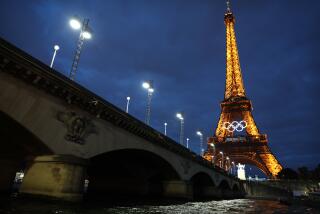Paris’ Bastille District : Cafe Cool : An Old Quarter Is Newly Hot
- Share via
PARIS — The rich get richer. And Paris, which didn’t particularly need another lively neighborhood, has one.
Despite the gloom of recession throughout Europe, the last few years have brought new eateries, operatic strains, modern architecture, daring galleries and youthful energy to the formerly workaday and blue-collar Parisian neighborhood surrounding the old Bastille prison site. The Bastille building itself, long associated with the revolution of 1789, is long gone. But the July Column, the 170-foot-high monolith commemorating lives lost as 19th-Century Parisians struggled against later oppressors, is surrounded each night by alfresco diners, strolling musicians, preening motorcyclists and general hubbub.
Arnaud Dupont, a 28-year-old Parisian I found dining in the elegant Bistrot du Dome--then in its fourth month of operation just a block from the July Column--explained it all this way: “When (the district of) Montmartre got very boring, because it got taken over by second-generation, non-trendy adults, people came here.”
Beyond that, added his friend Rolande Claude, the inclinations of the pop culture kids in this neighborhood happened to agree with the ambitions of local government. The Paris politicians “really want to see this area grow in popularity,” Claude said. “It used to be a real pauper.”
All this energy caught me off guard when I straggled into the neighborhood last summer. The Place de la Bastille lies at the east end of the city, on the Right Bank of the Seine River, and acts as a hub from which the city’s 4th, 11th and 12th arrondissements radiate. Its neighbors include the Marais district, an area once regal, later neglected and resurgent again, with government backing, over the last 30 years. Still, until recently the Bastille area was best known as a neighborhood of furniture-finishing shops and wholesale wine warehouses.
I had come to the Bastille area because the hotels were cheaper than in the fancier neighborhoods near the city center, and because a Metro stop was handy. But as soon as I could be rid of my bags, I found my way to a sidewalk-view seat beneath the July Column, hoisted a Judas--that’s a Belgian brand of beer--and set to people-watching.
It was about 10:30 in the evening. A jazz band by the curb was grooving along on “Straight No Chaser,” and the sun had just dipped beneath the skyline. (It’s easy for an American to forget that Paris is as far north as Vancouver.) Down the narrow neighboring streets, the trendy restaurants and bars were bustling in all their glory--the Bofinger brasserie and bistro on Rue de la Bastille, for instance, and the Blue Elephant on Rue de la Roquette, Chez Paul on Rue de Charonne, the China Club on Rue de Charenton, and on and on.
The next night, I found my way to Rue de Lappe, which has been the liveliest street in the neighborhood for decades. Edith Piaf is said to have sung here 60 years ago in the Balajo dance hall, whose sign still casts a red neon glow on passersby. On weekend nights, the press of students and young revelers makes automobile passage down the narrow lane almost impossible.
On the night of my tour, in the Crepes Show restaurant, at 51 Rue de Lappe, half a dozen fish circled in a globe-shaped fishbowl, a mannequin stood draped in black by the door, and two dozen candle-lit, late-night diners conspired over lemon, chocolate and banana crepes.
At Tapas Nocturne, at 17 Rue de Lappe, bullfight paintings hung on a stone wall, and a pair of guitarists flailed furiously, sounding about as Spanish as a practitioner of flamenco can sound.
Instead, they turned out to be representatives of the new Europe without borders--the new world without borders, in fact: one was Japanese; the other, Argentine. Still, they had the attitude, and so did their listeners.
Those crowded around--some just a foot or so from the performers in the warm, small room--wore expressions simultaneously fierce and jovial. A sign on one wall announced a special of the house: “Sangre de Toro,” for about $16. Not actual bull’s blood, surely. But what? I never found out.
Up and down the block there was Thai food, fish and chips, an ersatz American diner, the Iguana Cafe, Rio Grande, the Del Rio Cafe and half a dozen bistros.
“The neighborhood was very old before. In the buildings, a lot of laborers and furniture businesses. Now, as Paris becomes more expensive, they rebuild the hotels and the restaurants,” said Rudolphe Leroux, a neighborhood resident for most of his 23 years.
In the Chinese and Japanese restaurants on nearby Rue de la Roquette just a few years ago, Leroux recalled, “it was 100 francs (about $18), and you could eat everything you wanted. Now, it’s 200.”
As Leroux spoke, he stood in the modest lobby of the Libertel Bastille, yet another sign of the Bastille’s resurgence. An aged hotel property, the site was sold, renovated and then reopened in March, 1993, as a crowded but clean lodging with prices that young travelers can afford--well under $100 nightly.
As such developments progress, some worry that the loft-dwellers who helped spark the neighborhood’s new energy will all be driven out. But that’s not going to slow anything down.
“Every month, there is something new opening,” said Michel Arnaud, proprietor of Le Pavillon Bastille, a striking post-modern hotel around the corner on Rue de Lyon.
Arnaud opened in May, 1991, hoping to draw patrons of the sophisticated new opera house that had officially opened on the Place de la Bastille, and says he’s been so pleased that he’s considering another hotel venture on the other side of the July monument.
Near the Bastille Metro stop, meanwhile, city planners have seized another opportunity. Between Boulevard Bourdon and Boulevard de la Bastille, where the waters of the Canal St. Martin emerge from their underground course toward the Seine, city officials in the mid-1980s created a pleasure boat harbor. It’s known as the Port de Plaisance de Paris Arsenal , and includes about 200 slips.
But the biggest opening in the neighborhood’s last decade, hands down, has been the hulking opera house that stands near the footprint of the old prison.
The original Bastille was built as a moated fortress for Charles V in the 14th Century, but later converted to its more infamous use as a prison primarily for political dissidents.
Convicts included the philosopher Voltaire and the Marquis de Sade (presumably not in the same cell), but by the last years before the French Revolution in the 18th Century, the prison population had dwindled to almost nothing. Still, the masses needed a target to march on in 1789, and eventually, probably in search of weapons, they charged the Bastille and released the seven prisoners inside. Within a year, the old prison was demolished, but the name was set in historical vocabulary.
Much of the site, meanwhile, was taken over by a railway station from 1859 to 1970, then converted into an exposition hall. Instead of the prison, the neighborhood took as its identifying monument the 170-foot-high July Column, constructed in 1840 as a reminder of the hundreds of Parisians who died in skirmishes leading up to the fall of Charles X in 1830.
The project to build an opera house near the old prison site began under Socialist President Francois Mitterrand in the early 1980s, and climaxed with the new building’s official opening on July 14, 1989--the 200th Bastille Day.
*
The building, designed by Canadian-Uruguayan architect Carlos Ott, more closely resembles a downtown bank tower than it does the curlicued 19th-Century lines of the city’s most famous opera house, the Opera de Paris Garnier.
But the Opera de la Bastille is undeniably striking and modern. From anywhere around the Place de la Bastille, you can’t look up without confronting a broad, curving face of glass and metal rectangles. Inside is a stark 2,700-seat main auditorium, covertly served by all manner of stage hydraulics and modern theatrical technology.
Early on in the project, there was much talk about making this an opera house for the masses. As it worked out, it’s an opera house for those among the masses who care to pay $24-$104 for a reserved seat (though those who appear at the door have a chance at gallery seats for about $11). After the show, many of the operati settle in next door at Fouquet’s brasserie and restaurant, a recent satellite venture of the eatery best known for its Champs-Elysees location.
At least some of the non-paying masses, however, have found a use for the opera house: Waiting for friends or merely loitering, young Parisians gather nightly to sit, slouch, gossip, admire each others’ scooters, and laconically smoke on its stone front steps. An excellent Parisian solution: While the rich get richer, the idle get idler.
GUIDEBOOK
Storming the Bastille
Getting there: From LAX to Paris, there are regularly scheduled nonstop flights on Air France (daily) and United (thrice weekly); connecting flights on American, Delta, Continental, Northwest, TWA, USAir, Swissair, SAS, KLM, Lufthansa and British Airways. Round-trip fares with 14-day advance purchase are about $990.
Where to stay: Le Pavillon Bastille (65 Rue de Lyon, Paris 75012; telephone 011-33-1-43-43-65-65, fax 011-33-1-43-43-96-52) gleams in blue and yellow postmodernism. Twenty-five rooms, with elevator and air conditioning. Double rooms rent for about $162 nightly.
Libertel Bastille (14 Rue de la Roquette, 75011; tel. 011-33-1-47-00-56-02, fax 011-33-1-47-00-39-33) is modest and elevator-less, but clean, and staffed by helpful, multilingual young people. Thirty rooms. No air-conditioning. Double rooms rent for $82-$95 nightly.
Hotel Les Sans-Culottes (27 Rue de Lappe, 75011; tel. 011-33-1-49-23-85-80, fax 011-33-1-48-05-08-56). For the young and footloose who don’t mind a little tumult in the street below. Guest rooms are stacked over an Art Nouveau bar and restaurant. Not much English spoken. Renovated in 1992, which brought new plumbing, but no elevator and no air-conditioning. Showers, no tubs. Ten rooms. Double rooms nightly: about $64.
Where to eat: Crepes Show (51 Rue de Lappe, Paris 75011; local tel. 47-00-36-46) is a good, unpretentious stop for dessert.
Tapas Nocturne (17 Rue de Lappe, Paris 75011; tel. 43-57-91-12), is more for drinking and listening to flamenco than for eating.
Le Bistrot de Bofinger (6 Rue de la Bastille, Paris 75004; tel. 42-72-05-23). Mosaic tiled floor, murals, brass and mirrors, and a slice of avocado is the salad. Dinner main courses: $12-$15.
Bistrot du Dome (2 Rue de la Bastille, Paris 75004; tel. 48-04-88-44). Dinner main courses: $15-$24.
For more information: French Government Tourist Office, 9454 Wilshire Blvd., Suite 715, Beverly Hills 90212; tel. (900) 990-0040 (calls cost 50 per minute).
More to Read
Sign up for Essential California
The most important California stories and recommendations in your inbox every morning.
You may occasionally receive promotional content from the Los Angeles Times.











